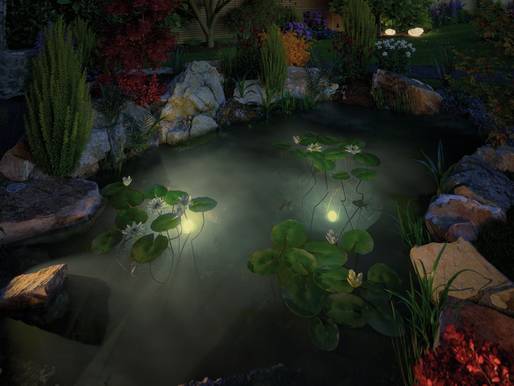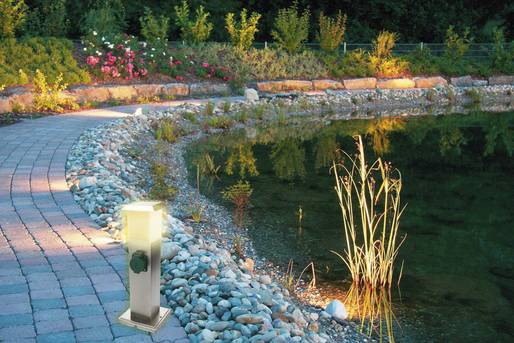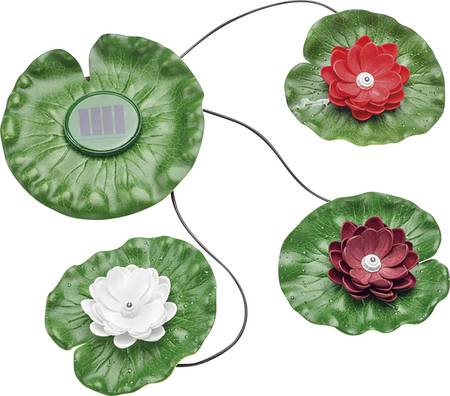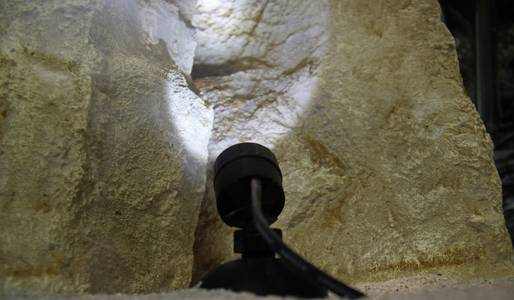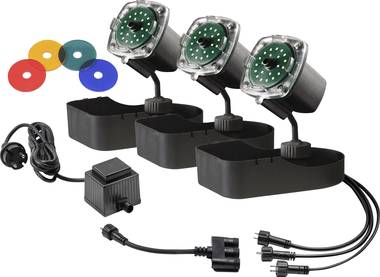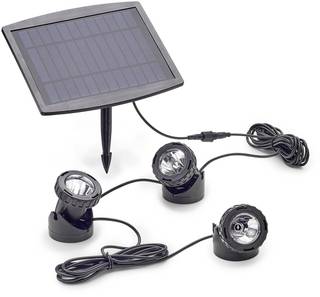Pond lighting » Lighting ideas for the garden pond
Published: 13.09.2021 | Reading time: 5 minutes
This text is machine translated.
With the help of pond lighting, you can create a beautiful ambience for your pond. You can choose between many different options.
Whether lighting for the edge of the pond, floating lighting or underwater lighting - you set the lighting highlights according to your ideas.
Emphasize the most beautiful objects in and around your pond. You can vary the light from ground lights and spotlights as you wish.
LED pond lighting is very well suited for use on and under water.
Warm white light has a calm and cozy effect, while cool white lamps have an invigorating effect - your garden - your choice.
Regardless of whether you want to start with a starter set, LED rings or LED spotlights in your garden: The combination of “LED” and “solar” is a very good combination for lamps, on and under water. Why? We explain this in the following section.
Pond lighting at the edge of the pond
In addition to creating a special atmosphere, lighting at the edge of the garden pond also contributes to the safety of people and animals.
It provides additional path lighting. The water is much easier to see, minimizing the risk of someone falling in.
LED lamps with solar power are particularly suitable. This eliminates the need to lay power cables, which would have to be taken into account when planning a pond in a private garden or company garden.
This means you remain flexible at all times when it comes to designing with light.
Pond lighting on the water
Floating lights on the pond have a fascinating effect. They create a pleasant atmosphere and a special flair. As the use of well-known floating candles (with a burning time of approx. five hours) can become quite expensive in the long run, it is worth looking at inexpensive alternatives for your garden pond.
These include floating balls or other floating forms such as water lilies. They very often have LED lights and solar cells for power supply. A typical feature of LED lighting is the ability to set different colors.
Whether warm white, cool white or colorful - many color combinations are possible, depending on the lamp used. As interesting and beautiful as these plays of color are, they can also quickly appear kitschy or overloaded. This is why this type of lighting should not be overdone.
Pond lighting under water
Underwater lighting sets beautiful accents, is usually equipped with modern LED technology and therefore often consumes very little power. It must be designed for permanent use under water (see “Safety first! - IP protection classes”).
You can choose between waterproof LED spotlights for the inside edge of the pond or waterproof LED spotlights for the floor. When using underwater, the nature, location and size of the pond should be taken into account.
It is of course possible to combine different types of lighting.
If you want to illuminate your garden pond, then many people are quickly faced with the question of whether they want to do this with solar lights. Using solar means being able to save electricity and being flexible. What many people don't know: It is also possible to save energy with decentralized lighting. Well-planned lighting concepts set specific focal points in the pond and garden. Whether rose arches, particularly beautiful plants or waterfalls, decentralized lighting shortens the distance between the light source and the object. This alone means that less energy is required.
Pond lighting with LED instead of halogen
The features of modern LED technology are quickly summarized:
Lots of light and a long operating time.
Compared to halogen lamps, LEDs have a light duration that is more than ten times longer and consume up to 80 % less energy.
The advantages over halogen headlights are therefore obvious. It is possible to start with a simple LED set. Later, you can expand this as you wish.
Pond lighting with solar energy
Solar lamps are the most cost-effective way of providing atmospheric lighting for ponds and gardens in the long term. Once purchased, there are no further follow-up costs, for example for the power supply.
One disadvantage to bear in mind is that the solar cells of the lamps may not receive enough sunlight during prolonged periods of unfavorable weather. For this reason, the lighting may fail at times.
Regardless of this, solar lamps are quick and easy to install without expert knowledge and are also very flexible in terms of location.
The fact is that the combination of water and electricity can be (life) threatening. Many water lighting systems, such as spotlights, do not work without electricity. For this reason, you should inform yourself very carefully and seek professional advice before making a purchase. If you want to be absolutely sure, you should have your pond lighting installed by a specialist.
Observe IP protection class
When selecting pond lighting for your garden, for example, you need to make sure that it is really suitable. This is because, depending on where it is used, it must be protected from splashing water or other external influences such as moisture.
The IP protection class indicates exactly where the lighting can be installed. With the help of a table, you can quickly find the right light you are looking for in our “IP protection classes and types of protection” guide.
It goes without saying that the underwater lighting should really be suitable for continuous underwater use. But even lamps that are set up at the edge of the pond should not be affected by occasional flooding. It is definitely worth investing in quality here. Only then will you be safe and enjoy the beautiful ambience of an illuminated pond for a long time. Whether in a private garden or a company garden..
In terms of sustainability, you should not turn your beautiful garden oasis into an “over-lit” object for the sake of animals and the environment. Less is more also applies to the number and size of the lights that are installed. These should be matched to the size of the pond. Perhaps start with a small waterproof LED set.
In addition to the negative visual impression for humans, too much light and color can torment the animals in and around the pond. They also have a day-night rhythm and need dark retreats without lights. As some fish species only become really active in the dark, LED pond lighting should not be left on all night.
Last but not least, a well-set light-dark contrast through lighting makes your pond look lively and makes it really interesting.
Our practical tip: The right light hardly attracts any insects
If you are worried that beautiful pond lighting will attract too many insects, you can rest assured. The majority of insects are nocturnal and respond to short-wave, bluish light. Light attracts them almost magically, as many insects use the moon (light source) as a point of orientation. By choosing the right light source, up to 90 % fewer insects are attracted. In addition, warm white light (2,700 - 3,000 Kelvin) specifically emphasizes the calming effect of your garden pond.
By the way: A short distance between the illuminated garden object and the lamp is also helpful to avoid attracting insects.
Technical terms in lighting technology explained clearly
A wide variety of designations, specifications and technical terms are used in the field of lighting technology. However, it is not always clear exactly what is meant. That is why we have tried to explain all the common technical terms relating to lighting in an understandable way. "To the lighting technology terms guide ”
